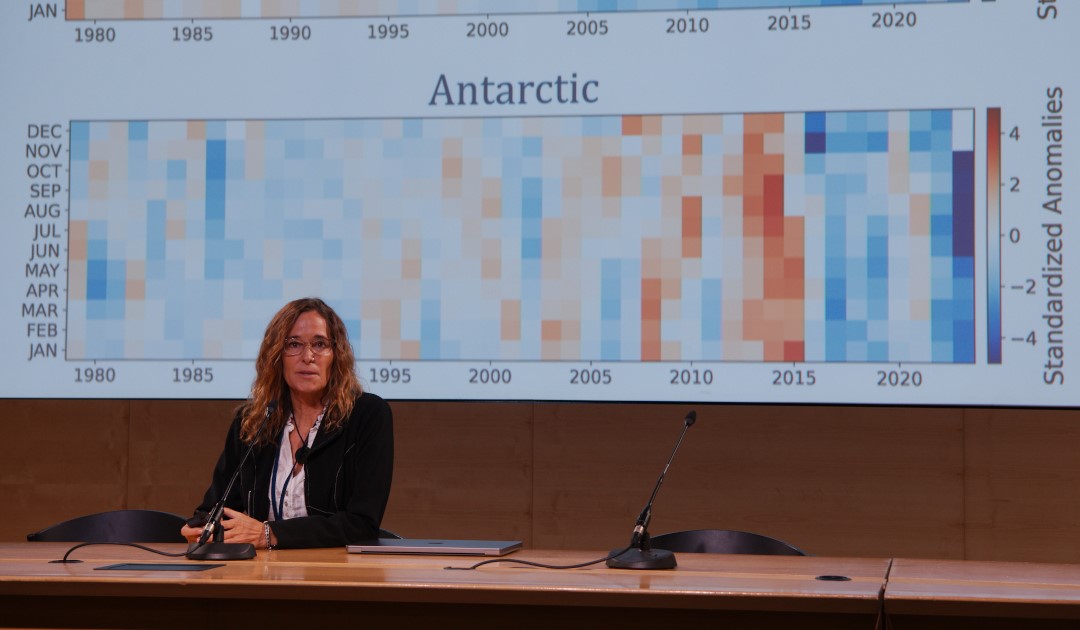
The first day of the One Planet – Polar Summit ended with informal discussions yesterday after 10pm alongside the animals in the Muséum d’Histoire Naturelle’s evolution gallery, while it started in the middle of the gardens, in the Verniquet amphitheatre, with the launch of the forum. It was a day of lively, psalmodic scientific presentations on the state of the cryosphere. By inviting international experts, they drew up the most up-to-date findings, with the utmost precision.
The retreat and expansion of sea ice in the Arctic (north) hit a record anomaly in 2020, while in the Antarctic (south), the biggest anomaly was recorded just in July 2023. Sea ice in the south had continued to grow until 2015, but has been losing significant amounts ever since.
Still in the south, fluctuations in sea ice are becoming increasingly significant, with ever wider variations between retreat and expansion. As a result, these fluctuations are moving away from the average around which they used to revolve. It’s still too early to tell, but 2023 could herald a regime change.
To the north, sea ice will not disappear. At the height of winter, when night is permanent, it will still form. However, the various scenarios show a drastic reduction of persistence in the coming years.
The relationship between greenhouse gases emitted by human activity and the loss of sea ice is scientifically established by a simple equation. The more carbon there is in the atmosphere, the less sea ice there is on the ocean. According to this, for every tonne of carbon, sea ice loses 2.6 square metres.
The formation of sea ice is linked to continuous changes in the circulation of air masses. Yet the mechanisms at work at high altitudes are still poorly understood by science. Indeed, the jet stream and even the ozone layer are likely to influence the evolution of sea ice.
When ice gives way to water, the increase in steam and the formation of clouds could strengthen the greenhouse effect. But again, the lifespan of clouds is poorly understood, as is the role of precipitation in the Antarctic water cycle.
When sea ice forms, the water becomes briny as it solidifies. The layers of water containing this excess salt are denser and sink deeper thereby driving the ocean currents. Less sea ice means a less salty ocean and potentially less powerful currents, further weakened by the inflow of fresh water from the ice cap.
It is possible that these submarine cascades sink less deep and, as a result, slow down the absorption of atmospheric carbon, creating a flow of warmer water towards the surface. However, to confirm this, scientists will need to study the Arctic and Southern Oceans in greater detail, as they are infrequently visited in summer and even less so in winter.

More measuring instruments drifting or anchored in the ocean, more observations in the center of the Arctic, more satellite observations, better access to data and more time to examine them. The list of technical recommendations to improve scientific results was long and diverse at the forum.
Allies for scientists
Ice also provides the substrate on which life clings. At the poles, micro-organisms in particular are unique, not only because they are adapted to the cold, but also because their genome is unmatched anywhere else on the planet. And they are important, too. In addition to producing gases, some of which have a cooling effect, phytoplankton is the main source of organic matter, which feeds the entire Polar food web.
On the other side, scientists turn to Antarctic predators in the search for allies. Equipped with sensors and loggger, these allies bring back valuable information from the depths of the ocean or from under the sea ice.

By combining such data e.g. from the hunting behavior of penguins with similar data from of seals, whales and orcas, scientists can create a detailed map of their home ranges showing where life thrives most in the vastness of the Southern Ocean. Such a map then helps political decision-makers to create marine protected areas.
But this biodiversity is under threat: data from Thai polar researchers for example showed a significant increase in the number of parasites in ice fish. According to them, increasing pollution from fossil fuels is responsible for this.
Reducing greenhouse gas emissions is an imperative recommendation. This applies both to the way societies function and to science, which is questioning its own practices.
Scientific efforts can focus on greater cooperation, relocating scientific expertise as close as possible to the areas concerned, as close as possible to the actual field, as it happens in Australia, New Zealand, Chile and Argentina. In the north, too, as close as possible to the Inuit communities, who must also be allowed to decide their own course of action, for example with regard to increased shipping traffic in the Northwest Passage, which presents both risks (pollution) and benefits (supplies) for coastal communities. For their part, scientists are calling for an analysis of the impact of future traffic.
They also call for more regular analysis of sea-level rise, caused in part by melting ice caps and glaciers and warming water. Because every centimetre of rise has an impact on two million people.
The stability of the ice caps depends on the landforms on which their grounding line rests, but here too scientists see a lack of data on these areas, which are crucial for estimating the crossing of thresholds. Beyond which, glaciers will be forced to disappear.
This uninterrupted, mantra-like flow, describing the latest discoveries and issues in the polar and high-altitude domains, validated the main themes of a list of recommendations under the watchful eye of 300 specialists. It will be handed over to political decision-makers tomorrow. It remains a secret for the time being, as do the commitments to action that will be declared on Friday.
Camille Lin, PolarJournal
Learn more about this topic:





